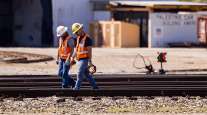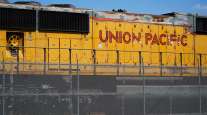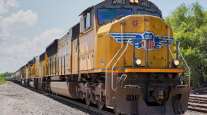Senior Reporter
Union Pacific Reports Lower Q1 Earnings

[Stay on top of transportation news: Get TTNews in your inbox.]
Inclement weather in much of the area where Union Pacific Railroad operates — Midwest, South and parts of Texas — is being blamed for the decline in first-quarter earnings.
The Omaha, Neb.-based carrier on April 22 said net income dropped 9% to $1.34 billion, or $2.01 per diluted share, compared with $1.47 billion, $2.15.
Revenue also declined 4% to $5 billion from $5.22 billion.

Kansas City Southern
More Rail News
In February, Texas was hit with a weeklong record cold snap that shut down much of the state’s electrical grid.
The company’s quarterly operating ratio worsened slightly in the first three months to 60.1 from 59 a year ago.
Operating ratio, or operating expenses as a percentage of revenue, is used to measure efficiency. The lower the ratio, the higher the company’s ability to generate profit.
“We generated solid productivity through efficient use of our resources despite the significant weather event that covered most of our network in February and early March,” CEO Lance Fritz said.
Revenue across the various business lines was mixed.
Grain increased 11% to $766 million from $689 million in 2020.
Fertilizer shipments fell 2% to $170 million from $174 million.
Food and refrigerated shipments declined 6% to $235 million from $250 million.
Coal and renewable energy products fell 19% to $341 million from $421 million.
Industrial chemicals and plastics fell 12% to $435 million from $495 million.
Metals and minerals dropped 20% to $375 million from $469 million.
Union Pacific $UNP Reports First Quarter 2021 Results https://t.co/d2WbILABUm — Union Pacific (@UnionPacific) April 22, 2021
Forest product shipments increased 4% to $316 million from $303 million.
Energy and specialized market products declined 15% to $530 million from $627 million.
Automotive shipments dropped 15% to $447 million from $524 million.
Intermodal shipments were up 11% to $1.03 billion from $928 million.
Union Pacific is one of several Class I railroads that have moved to boost efficiency through precision scheduling, which prioritizes moving freight with fewer railcars and locomotives and a simplified system across the network that relies on longer trains with fewer employees. Company officials insist that the business model is working and point to the fact that in the last year the average length of train cars has increased by 10% to where now the average maximum train length is 9,247 feet, or equivalent to 1.75 miles. In 2020 the train car average was 8,396.
That increase in efficiency is one of the reasons why, that even with the rising price of diesel fuel, the railroad said its fuel bill in the first quarter fell 5% to $411 million from $434 million in 2020.

Even at Level 4 autonomy, self-driving trucks will have technical limitations. In this episode, we ask how technology developers are clearing those hurdles to make autonomous trucking a reality. We bring in Boris Sofman, head of engineering for the autonomous trucking program at Waymo. Hear a snippet above, and get the full program by going to RoadSigns.TTNews.com.
On a conference call with analysts and reporters, company officials weighed in on the potential sale of Kansas City Southern to either Canadian Pacific for $25 billion or Canadian National for $33.7 billion. Kansas City Southern is the only Class I railroad that operates deep into Mexico, and analysts say those routes are especially valuable now that the United States, Mexico and Canada have ratified a new North American trade agreement that extensively opens up markets in the three economic powerhouse nations.
Union Pacific officials said at this time they have no plans to be involved in mergers and acquisitions, but they’re watching the battle closely because of the potential impact it will have on the freight rail industry.
“What we are focused on is what the Surface Transportation Board said the next Class I merger must provide, which is enhanced competition and an improvement for all customers,” Fritz said.
Want more news? Listen to today's daily briefing below or go here for more info:




